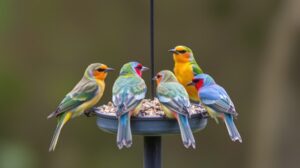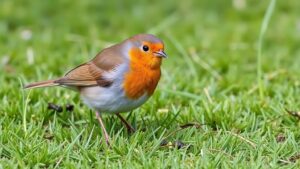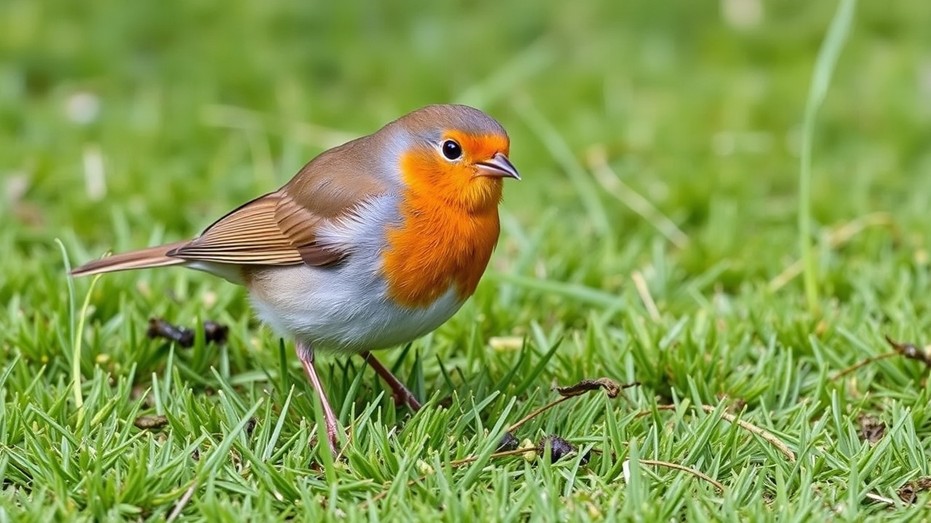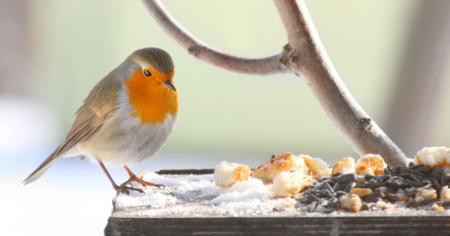Are you finding the answer to the question: “What do robins eat?” If so, then you have come to the right place. Attracting robins to your garden can be a delightful experience, especially when you understand what these charming birds eat. Robins are known for their vibrant colors and melodic songs, making them a favorite among bird watchers.
However, to entice robins to visit your space, you must provide the right food. This article will explore robins’ dietary preferences, including their natural diet and the best foods to offer. Along with tips on attracting robins to your garden year-round.
Understanding What Do Robins Eat
To effectively attract robins, it’s crucial to comprehend their dietary habits. Robins eat a variety of foods, primarily consisting of insects, worms, and berries. They are particularly fond of worms, which they hunt for on the ground.
Their natural diet also includes beetles and a range of small fruits, making your garden a potential haven for these wild birds. During the colder months, when natural food sources become scarce, robins can benefit from supplemental bird food. Providing diverse options is the best way to ensure robins thrive in your garden.
1. Natural Diet of Robins
Robins feed primarily on earthworms in the wild, making them natural ground feeders. They forage for food on the soil, using their keen eyesight to spot potential meals. Robins love to eat various berries, including blueberries and raspberries, which they find in shrubs and trees.
These fruits not only provide essential nutrients but also offer hydration. By planting berry-producing shrubs in your garden, you can create an inviting habitat for robins, encouraging them to visit regularly and establish nests nearby.
2. Common Foods to Feed Robins
To attract robins to your garden, consider offering them bird food that mimics their natural diet. Mealworms, either live or dried, are particularly appealing to robins and can be easily put out for robins in feeders or on a ground feeding tray.
Suet is another beneficial option, especially during wintertime, as it provides energy-rich fats. Sunflower hearts and raisins can also entice robins, attracting them to your bird feeder or table. Remember that robins are larger birds, so provide ample food to accommodate their needs.
3. Seasonal Variations in Diet
Robins’ diets can vary significantly with the seasons. During spring and summer, they primarily consume insects and berries, which are abundant during these warmer months. As the weather cools in fall and winter, robins may migrate to areas with more plentiful food.
A consistent supply of bird feed, including fat balls and dried mealworms, is essential to keeping robins in your garden during these colder months. By ensuring a year-round food source, you can create an environment that encourages robins and other birds to visit consistently.
Effective Ways to Attract Robins to Your Garden
1. Creating a Suitable Habitat
Creating a suitable habitat that meets their needs is vital to attracting robins to your garden. Robins thrive in environments rich in natural elements, such as shrubs and trees that provide shelter and nesting opportunities.
By planting berry-producing shrubs, you enhance your garden’s aesthetic and offer a food source for robins. Leaving areas of the garden undisturbed allows earthworms and beetles to thrive. Which are essential components of the robins’ diet. The presence of water sources, like birdbaths, will further entice robins to visit and stay in your garden throughout the year.
2. Using Feeders to Attract Robins
Implementing bird feeders is an effective strategy to attract robins to your garden. While robins are primarily ground feeders, hanging feeders can still be beneficial if filled with appealing food options. Consider using a bird table or a ground feeding tray designed for larger birds.
This will allow robins to access a variety of foods comfortably. When setting up feeders, ensure they are situated in safe areas, away from predators, and close to natural shelter. By putting out mealworms, sunflower hearts, or suet, you can create a welcoming space that entices robins and keeps them returning for more.
3. Choosing the Right Bird Food
Choosing the right bird food is crucial in attracting robins to your garden. Robins love to eat mealworms, whether live or dried, as they mimic their natural diet.
Offering fruits like raisins and berries can entice robins to visit your feeders. Suet is another excellent option, especially during the colder months, as it provides essential fats that robins need for energy.
It’s important to provide a variety of food types, including sunflower seeds and fat balls, to cater to the preferences of robins and other garden birds. By ensuring a diverse selection of bird food, you will create an inviting atmosphere for robins and encourage them to thrive in your garden.
Feeding Robins: Best Practices
1. Types of Food to Offer Robins
Offering the right food types is pivotal to attracting robins to your garden. Robins need a balanced diet mimicking their natural feeding habits, primarily of worms, insects, and various berries. To entice robins, consider providing a mix of dried mealworms, which they love, alongside fresh fruits like raisins and berries.
Incorporating sunflower hearts into your bird feed can make your garden more appealing. By offering a variety of food options, you not only cater to the dietary preferences of robins but also create an environment that promotes their health and well-being throughout the year.
2. Mealworms: A Favorite Treat
Mealworms are a favorite treat for robins and stand out as one of the best foods. Whether you choose to put out live or dried mealworms, you can be sure that robins will be drawn to them. These tiny, protein-rich larvae are an excellent source of nutrition, particularly during the colder months when natural food sources may be limited.
By placing mealworms in a suitable feeder or on a ground feeding tray, you can effectively attract robins to your garden. Observing these wild birds as they eagerly feed on mealworms is a rewarding experience for any bird enthusiast.
3. Sunflower Hearts and Other Seeds
Sunflower hearts are another fantastic option for feeding robins and can easily be included in your bird food offerings. These nutrient-rich seeds are favored by robins and attract a variety of other garden birds, creating a lively atmosphere in your outdoor space.
Consider adding other seeds to your bird feeder, such as millet or safflower, along with sunflower hearts. Providing these options ensures that robins and other birds in your garden have ample food choices, catering to their diverse preferences. Ultimately, a well-stocked feeder with sunflower hearts and seeds will entice robins and encourage them to visit regularly.
Encouraging Robins to Nest in Your Garden
1. Ideal Shrubs for Nesting
Creating an inviting environment for robins in your garden starts with selecting the right shrubs that cater to their nesting habits. Robins prefer dense, thorny shrubs, such as holly or blackcurrant, which provide shelter and protection from predators.
Berry-producing shrubs can attract robins by offering a food source that complements their diet. When you plant these shrubs strategically around your garden, you enhance the aesthetic appeal and encourage robins to establish nests nearby. Providing a safe and supportive habitat is essential for encouraging a higher number of robins to take up residence in your garden.
2. Importance of Water Sources
Water sources are crucial in attracting robins to your garden, as they need access to clean water for drinking and bathing. A birdbath or a small pond can serve as an inviting oasis for these wild birds, especially during the warmer months when natural water sources may be scarce.
Keeping the water clean and refreshed will entice robins and other birds to visit regularly. During the colder months, maintaining an unfrozen water source is vital, as robins need hydration even when food is less available. Providing ample water not only assists in attracting robins to your garden but also enhances the overall ecosystem.
3. How to Help Robins During Breeding Season?
During breeding season, robins require additional support to thrive and successfully raise their young. You can assist robins by ensuring that your garden has ample food sources. Such as mealworms and berries are essential for feeding adult robins and their chicks.
Offering nesting materials like dried grasses, twigs, and leaves encourages robins to build their nests in your garden. Minimizing disturbances and providing a safe environment free from predators will also help increase the chances of successful nesting. Being proactive and attentive can significantly aid robins during this critical time in their life cycle.
Monitoring and Enjoying Robins in Your Garden
1. Identifying Robins in Your Garden
Identifying robins in your garden is a rewarding experience for bird enthusiasts. Robins are easily recognized by their bright orange-red breast and cheerful, melodious song. Observing their behavior can also help you spot them; they are often seen foraging for worms and insects on the ground.
During the breeding season, male robins can be particularly vocal, establishing their territory with a series of distinctive calls. Familiarizing yourself with these traits enhances your birdwatching experience and helps you monitor the health and activity of the robins in your garden.
2. Creating a Birdwatching Spot
Creating a dedicated birdwatching spot in your garden can enhance your enjoyment of the robins and other birds that visit. Consider setting up a comfortable chair or bench near your feeding area, where you can observe the robins as they feed and interact. Placing bird feeders in a visible location, such as near a window or patio, allows for unobstructed views.
Incorporating natural cover like shrubs and trees around your birdwatching spot can provide privacy while encouraging robins to feel safe. This setup makes it easier to watch robins and fosters a deeper connection to nature.
3. Documenting Robin Visits
Documenting your experiences with robins in your garden can be a fulfilling endeavor. Keeping a journal or log of the number of robins visiting, their behaviors, and the foods they prefer can provide valuable insights into their habits. You might also consider taking photographs or videos to capture their activities.
Which can enhance your understanding of their interactions in your garden. Sharing your findings with fellow bird enthusiasts can foster community and contribute to the collective knowledge about robins and their habitats. By documenting these visits, you create lasting memories that deepen your appreciation for these delightful birds.
Final Thoughts
Attracting robins to your garden requires a thoughtful selection of their favorite foods and a welcoming environment. Providing a variety of food options, such as mealworms, suet, sunflower hearts, and dried mealworms, will cater to their dietary preferences.
Incorporating feeders and ensuring ample nesting spaces amidst shrubs can create a haven for these charming birds. By understanding what robins eat and tailoring your garden to their needs, you help maintain their presence and enjoy the vibrant life they bring to your outdoor space. Embrace these tips to foster a thriving ecosystem and delight in the cheerful company of robins.








